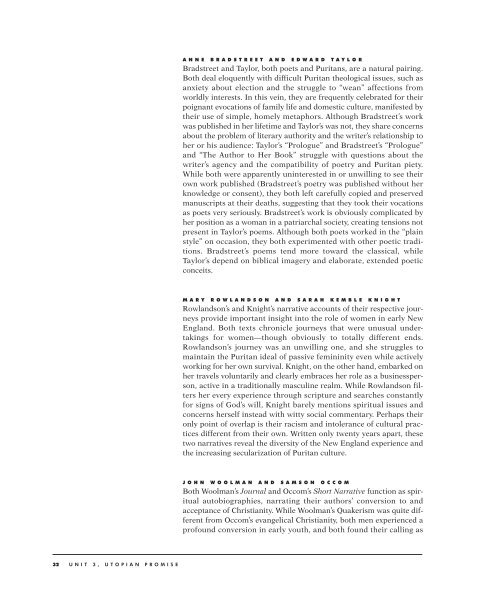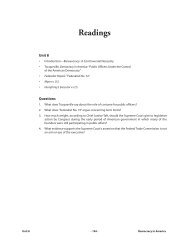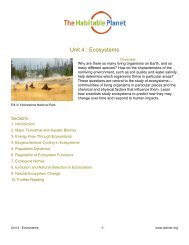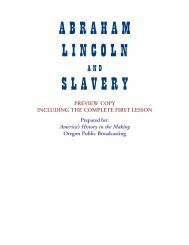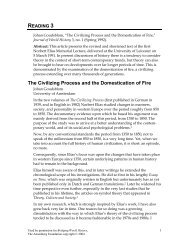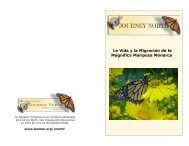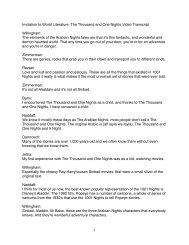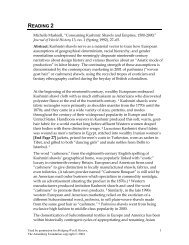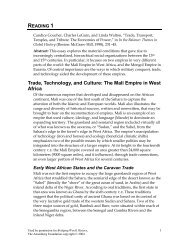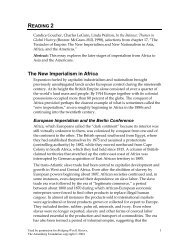UTOPIAN PROMISE - Annenberg Media
UTOPIAN PROMISE - Annenberg Media
UTOPIAN PROMISE - Annenberg Media
Create successful ePaper yourself
Turn your PDF publications into a flip-book with our unique Google optimized e-Paper software.
32 UNIT 3, <strong>UTOPIAN</strong> <strong>PROMISE</strong><br />
ANNE BRADSTREET AND EDWARD TAYLOR<br />
Bradstreet and Taylor, both poets and Puritans, are a natural pairing.<br />
Both deal eloquently with difficult Puritan theological issues, such as<br />
anxiety about election and the struggle to “wean” affections from<br />
worldly interests. In this vein, they are frequently celebrated for their<br />
poignant evocations of family life and domestic culture, manifested by<br />
their use of simple, homely metaphors. Although Bradstreet’s work<br />
was published in her lifetime and Taylor’s was not, they share concerns<br />
about the problem of literary authority and the writer’s relationship to<br />
her or his audience: Taylor’s “Prologue” and Bradstreet’s “Prologue”<br />
and “The Author to Her Book” struggle with questions about the<br />
writer’s agency and the compatibility of poetry and Puritan piety.<br />
While both were apparently uninterested in or unwilling to see their<br />
own work published (Bradstreet’s poetry was published without her<br />
knowledge or consent), they both left carefully copied and preserved<br />
manuscripts at their deaths, suggesting that they took their vocations<br />
as poets very seriously. Bradstreet’s work is obviously complicated by<br />
her position as a woman in a patriarchal society, creating tensions not<br />
present in Taylor’s poems. Although both poets worked in the “plain<br />
style” on occasion, they both experimented with other poetic traditions.<br />
Bradstreet’s poems tend more toward the classical, while<br />
Taylor’s depend on biblical imagery and elaborate, extended poetic<br />
conceits.<br />
MARY ROWLANDSON AND SARAH KEMBLE KNIGHT<br />
Rowlandson’s and Knight’s narrative accounts of their respective journeys<br />
provide important insight into the role of women in early New<br />
England. Both texts chronicle journeys that were unusual undertakings<br />
for women—though obviously to totally different ends.<br />
Rowlandson’s journey was an unwilling one, and she struggles to<br />
maintain the Puritan ideal of passive femininity even while actively<br />
working for her own survival. Knight, on the other hand, embarked on<br />
her travels voluntarily and clearly embraces her role as a businessperson,<br />
active in a traditionally masculine realm. While Rowlandson filters<br />
her every experience through scripture and searches constantly<br />
for signs of God’s will, Knight barely mentions spiritual issues and<br />
concerns herself instead with witty social commentary. Perhaps their<br />
only point of overlap is their racism and intolerance of cultural practices<br />
different from their own. Written only twenty years apart, these<br />
two narratives reveal the diversity of the New England experience and<br />
the increasing secularization of Puritan culture.<br />
JOHN WOOLMAN AND SAMSON OCCOM<br />
Both Woolman’s Journal and Occom’s Short Narrative function as spiritual<br />
autobiographies, narrating their authors’ conversion to and<br />
acceptance of Christianity. While Woolman’s Quakerism was quite different<br />
from Occom’s evangelical Christianity, both men experienced a<br />
profound conversion in early youth, and both found their calling as


